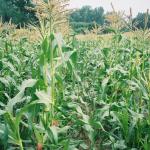Corn, Sweet
Sweet corn is a warm-season crop and one of the major vegetables grown in New England. It is an extremely popular crop for roadside stand sales.
Sweet corn grows on a wide range of soil types. Early planting should be on light, well-drained soil in a warm, sheltered location. Heavier soils are best for the main crop. Plowing under corn stalks and cover crops to maintain high levels of organic matter in soils is recommended for best crop production. Irrigation may only be necessary in dry weather, particularly on light soils, and especially as silking starts.
First plantings are made in early April in southern New England and in May in northern New England. Growers planting in cold soils run the risk of erratic germination and poor stands. Avoid planting while soil temperature is lower than 55°F. If soil temperature is below 60°F, it is advisable to plant treated seed. If you are planting untreated seed, wait until the soil temperature is at least 65°F. Most seed companies perform cold germination tests of their seed. If in doubt about the suitability of a corn variety for early planting, ask your seed dealer about the low temperature germination and vigor of the seed. Clear plastic mulch raises soil temperature can be used for the earliest plantings. This can provide corn 7 to 10 days earlier then non-mulched corn. Apply fertilizer and herbicides, and plant seed before laying the plastic over seeded rows. Two rows 18" to 24" apart are usually planted under each strip of 5'-wide plastic.
To avoid head injury, do not let temperatures beneath the plastic get too high (90°F or more). When such conditions occur, or when the plants reach 4" in height, cut slits in the plastic to allow heat to escape and plants to grow through. Remove the plastic completely by the time the corn is knee high to facilitate removal and permit cultivating.
Spunbonded row covers offer a potential three-way benefit for early sweet corn production. Maturity is increased by 5 to 10 days, yields are generally increased by 15 to 20%, and the first generation corn borer can be controlled if the covers are left on until after the peak of the first generation corn borer flight. They can also be used to pre-warm the soil before planting. They can be removed to allow planting and then replaced. Weight edges with soil to prevent damage by gusty winds, but leave adequate slack for plant growth to the tassel stage.
For Current information on production methods (including varieties, spacing, seeding, and fertility), weed, disease, and insect management, please visit the New England Vegetable Management Guide website
Major disease problems in this crop:
Major insect pests that affect this crop:
The Center for Agriculture, Food and the Environment and UMass Extension are equal opportunity providers and employers, United States Department of Agriculture cooperating. Contact your local Extension office for information on disability accommodations. Contact the State Center Director’s Office if you have concerns related to discrimination, 413-545-4800 or see ag.umass.edu/civil-rights-information.

